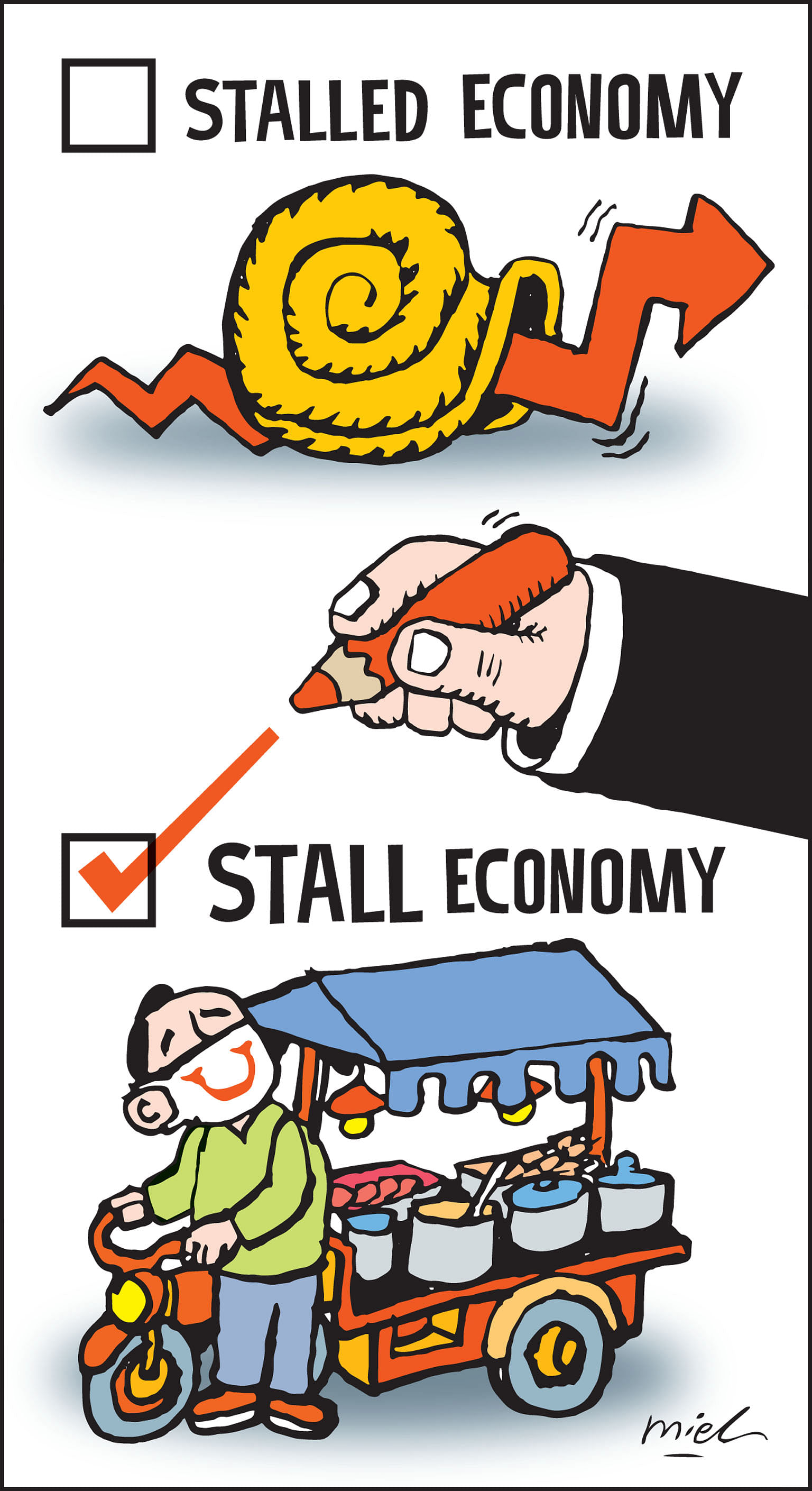The humble street stall recently came in for praise in the Great Hall of the People.
Speaking to reporters on China's efforts to create jobs in the Covid-19-stricken economy, Premier Li Keqiang commended Chengdu city for supporting the revival of mobile street stalls to create 100,000 new jobs.
One beneficiary of what has been dubbed by the media as "the stall economy" was 51-year-old Feng Jiali, an odd-job labourer turned braised-food seller who began to ply his trade from a second-hand cart in March.
Oblivious to the city's target of 36,000 mobile stalls to get the economy going, he had expected officials to give him grief when he started his business, but that did not happen, he told China Youth Daily.
The move by the western city of 16.3 million was controversial, as it went against a national drive to beautify Chinese cities by removing street vendors, who have also been blamed for assorted urban ills such as traffic problems and poor hygiene.
But these are grim times that call for extraordinary action.
Unemployment was already on the rise because of the protracted trade and tech war with the United States, and then came a second blow from the Covid-19 pandemic.
Speaking to reporters at the end of the annual session of the National People's Congress late last month, Mr Li said one-third of posts left by netizens on the government Internet portal were about jobs.
"Among the posts is one by a rural migrant worker in his 50s who has been working for more than 30 years away from home. This year, he could not find a job, and the whole family has fallen into dire straits," said the Premier.
Many self-employed were also struggling, with no work coming their way for months, he added.
Indeed, the figures are not pretty. In April, urban unemployment rose to 6 per cent, up from 5 per cent in the same month last year.
This figure does not take into account rural migrant workers. If they were included, April's jobless numbers would have been much worse - 20.5 per cent or 70 million people, according to a report by Chinese brokerage firm Zhongtai Securities.
So it was that Mr Li ditched the setting of a growth target - a practice of the central government since 1994 to guide economic development and measure government performance - in his work report at the start of the annual parliamentary session on May 22.
Instead, he emphasised protecting employment and living standards as well as alleviating poverty, with an eye on maintaining social stability.
China's rescue package includes 4 trillion yuan (S$787 billion) worth of cost cuts for struggling factories and micro, small and medium-sized enterprises (MSMEs).
The support - in the form of tax exemptions, lower bank interest rates and utility charges, and waived contributions to social welfare funds - is on top of another 2 trillion yuan in additional fiscal spending and government bond issuances.
IMPLICIT GDP TARGET
China's abandoning of a growth target this year has largely been seen positively by analysts.
Said Mr Tommy Xie, head of greater China research at OCBC Bank: "It is more realistic and sends a balanced signal to the market that China is still balancing between growth and containing unnecessary risk."
He added, however, that it may be more challenging for the central government and local governments to be on the same page without a quantified target.
Other analysts said that not setting a specific target will help avoid excessive short-term stimulus that could lead to asset bubbles. It will also give policymakers more wiggle room to adjust the pace and intensity of policies at a time of high uncertainty.
Yet, in the measures taken by the government, such as job creation, fiscal stimulus and M2 growth, is an implicit gross domestic product (GDP) growth target of around 2 per cent, according to some analysts.
Mr Xie said a 2 per cent internal target is plausible because it will allow China to meet its longstanding target of doubling income within a decade.
China had set a target of doubling its GDP and incomes by the end of this year from 2010, to build a "moderately prosperous society in all aspects".
While it will not be able to reach the goal of doubling GDP, which would require growth of more than 5 per cent, it can double its income if it grows by 1.75 per cent.
Mr Li, in his work report and later in his press conference, reiterated that building a "moderately prosperous society in all aspects" remains a goal.
But is eschewing a growth target a one-off because of the special circumstances, or will it be enduring?
To IHS Markit's Asia-Pacific chief economist Rajiv Biswas, many governments have been forced to take unusual measures because of the sheer scale of devastation caused by the Covid-19 pandemic.
"In the case of China, the pandemic has disrupted the normal planning process of setting growth targets. However, policy decisions taken during the pandemic crisis are not necessarily going to stay in place forever," he said.
Still, others like Mr Xie think it might be a catalyst for China to downplay the role of growth targets in the future and shift the focus instead towards boosting domestic demand and creating jobs.
Some have said moving away from a "growth-at-all-cost" mode of meeting targets would allow for more sustainable policies that can be tailored to the needs of the people.
Indeed, this is what appears to be happening, with the government doing away with a growth target but setting several goals that address specific economic issues such as employment and poverty.
FINDING RIGHT LIQUIDITY LEVEL
Given the already high national and corporate debt in China - a debt-to-GDP ratio of 270 per cent and 156.7 per cent respectively - there has been no replay of the 2008 strategy in response to the global financial crisis.
China, at the time, came up with a huge 4 trillion yuan stimulus package. The debt-fuelled state spending left the country with a serious debt overhang.
Prudence is key now, as Mr Li explained last month. "Just as water is important to fish farming, sufficient liquidity is important to economic development. We are now providing water so that the fish can survive - fish will die without enough water," he said.
"But excessive liquidity will induce froth in the marketplace, where some people may attempt to muddy the waters and fish for arbitrage."
Analysts have given estimates of the stimulus at 8 to 9 per cent of nominal GDP. This will be financed through a 3.6 per cent deficit, special central government bonds amounting to 1 per cent of GDP - smaller than expected by some analysts - and local government special-purpose bonds equivalent to 3.75 per cent of GDP.
MSMEs, which account for 60 per cent of GDP and hire more than 80 per cent of the workforce, are receiving much support, including an extension of the postponement of principal and interest repayments on loans to the end of next March. Large banks have also been directed to increase finance lending to such firms by 40 per cent.
More could be done, however, to ease burdens on costs such as providing wage subsidies and rental rebates, said Mr Xie.
As for investments, priority will be given to new infrastructure and new urbanisation initiatives that not only boost consumption but also "facilitate structural adjustments and enhance the sustainability of growth", said Mr Li.
New urbanisation initiatives include improving public facilities and services in county seats to meet the growing demand of rural residents to work and settle in these cities, said Mr Li in his report.
In April, the government said it would make it easier for rural residents to move to small cities to ease labour shortages and boost consumption as part of efforts to aid recovery.
New infrastructure building includes developing next-generation information networks, expanding 5G applications and building more charging facilities to promote wider use of new-energy vehicles.
Such projects are in keeping with the government's intention to move away from polluting, export-oriented manufacturing to an economy that is high-tech and service-driven.
Said HSBC Bank in a note: "These digital infrastructure projects will stimulate new consumer demand and lay the foundation for technological upgrading in the next decades, which means it can have greater multiplier effects compared with traditional infrastructure investment in the longer term."
But there is no getting away from traditional infrastructure building for a quick boost to the economy. So there will be major transport and water conservancy projects as well, including more railway lines.
MORE REFORM AND OPENING UP
The Chinese government has also pledged to foster an environment conducive to the development of the private sector by giving private firms equal access to production factors and policy support.
Traditionally, state-owned enterprises have had better access to loans and subsidies than private firms, and calls have been made to level the playing field for those in the private sector, including foreign firms.
The government also wants to encourage the upgrading of manufacturing, including through the use of the industrial Internet, and spur the growth of e-commerce and online services.
It is keen to boost domestic consumption at a time when overseas demand has slumped and the external environment has become more uncertain.
President Xi Jinping, at a meeting with top economic advisers last month, said China was pursuing a new development plan in which "domestic circulation plays a dominant role".
Perhaps the trade war and Covid-19 will spur the government to push reforms to help it shift towards a consumption-driven economy, such as by strengthening the social safety net so that people are encouraged to spend rather than save for a rainy day.
Already, plans are afoot to increase basic pensions for retirees. Subsistence allowances will be expanded to cover all families in difficulty, including migrant workers who have returned home. Government subsidies for basic medical insurance for rural and non-working urban residents will be raised.
Perhaps spurred by shortcomings in the healthcare system that Covid-19 has exposed, the government has also pledged to enhance the public health system and improve basic medical services.
There is something for foreign investors as well, with promises to open up the economy further by paring down the negative list for foreign investment as well as fostering a market environment in which all companies "are treated as equals and engaged in fair competition".
Some sceptics are wary of such promises, as similar ones have been made in the past but not quite followed through.
But if just some of the extraordinary measures taken - starting with the abandoning of growth targets and levelling the playing field for private firms - prove to be deep and enduring, then the Covid-19 crisis would have done some good as well, by being a catalyst for much-needed change.


